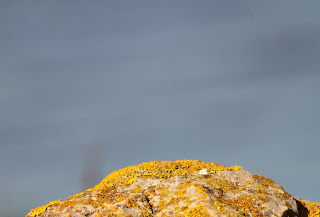Will and I returned to Rawcliffe Moss this morning for another ringing session where we hoped to catch more Redwings and Reed Buntings. The weather wasn’t as good as yesterday; in fact it was more than a little misty from the start with the murk hanging around for most of our three hour session. We got the nets up in record time, then waited for dawn and the Redwing’s arrival with a cup of coffee, listening to two Tawny Owls and watching a Red Fox cross through a field of sheep and towards the netting area. We didn’t see the animal later and it is not often we do so out here on the moss, but we do find signs of their activity.


We caught 26 new birds of 7 species, with no recaptures; 12 Reed Bunting, 7 Redwing, 2 Blackbird, 2 Goldfinch and 1 each of Lesser Redpoll, Dunnock and Blue Tit.
In the misty conditions visible migration was less obvious than recent days although Redwings were the most obvious and numerous once again, with a total count of approximately 300 birds in both quite small parties i.e. less than 10 birds, and somewhat larger groups of up to 60 birds. We saw small numbers of Fieldfares, often with the Redwings, but the larger thrushes numbered less than 20 in total. Other thrush migrants comprised several Blackbirds, 6 Song Thrush and 1 Mistle Thrush.


The Lesser Redpoll we caught was an absolutely immaculate adult male specimen-note the red tinged flanks and broad, slightly rounded tail feathers.

Below I posted a couple of Redwing pictures that show the ageing criteria between adult and juvenile birds. With good views in the field it might be possible to see these points. Juvenile tertial feathers usually show conspicuously tipped triangular white or buff marks, whereas on an a adult the tertial tips are evenly coloured with just the outermost parts edged whitish. Adult tail feathers are more rounded and generally broader than a juvenile’s.


After 8 Reed Buntings yesterday, our catch this morning of 12 more new birds represented perhaps a third of birds seen and heard this morning, as once again they were both visibly and audibly conspicuous with many moving south throughout the morning. Meadow Pipit migration was much less obvious today with a total count of about thirty birds only, perhaps not surprising in the misty conditions. Finch movements consisted of approximately 60 Chaffinch, 6 Siskin, 2 Redpoll, several Linnet, plus 40 or more Goldfinch, the latter two almost certainly local feeding birds.





























































.jpg)











